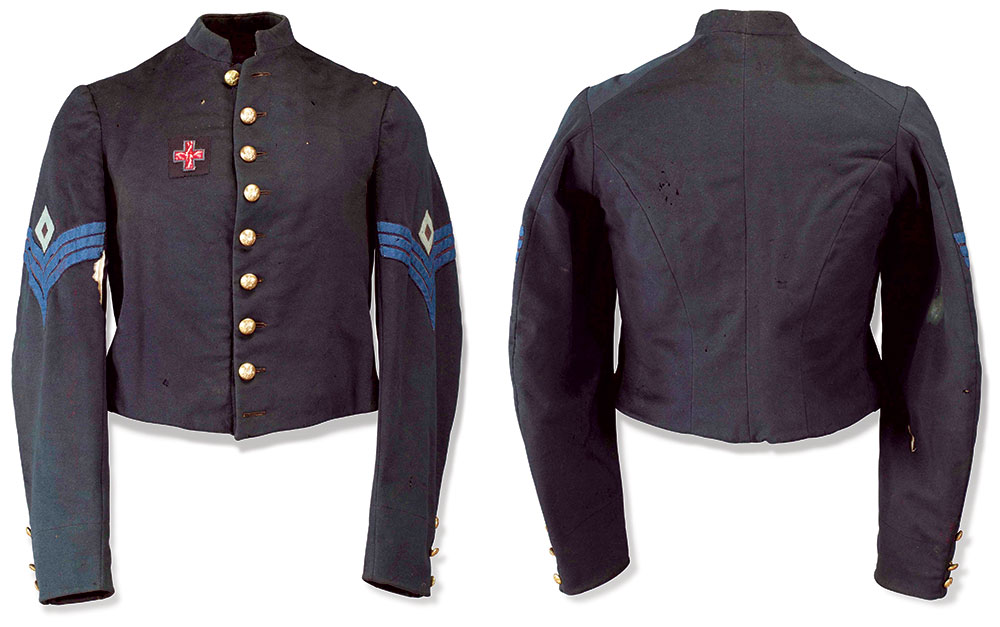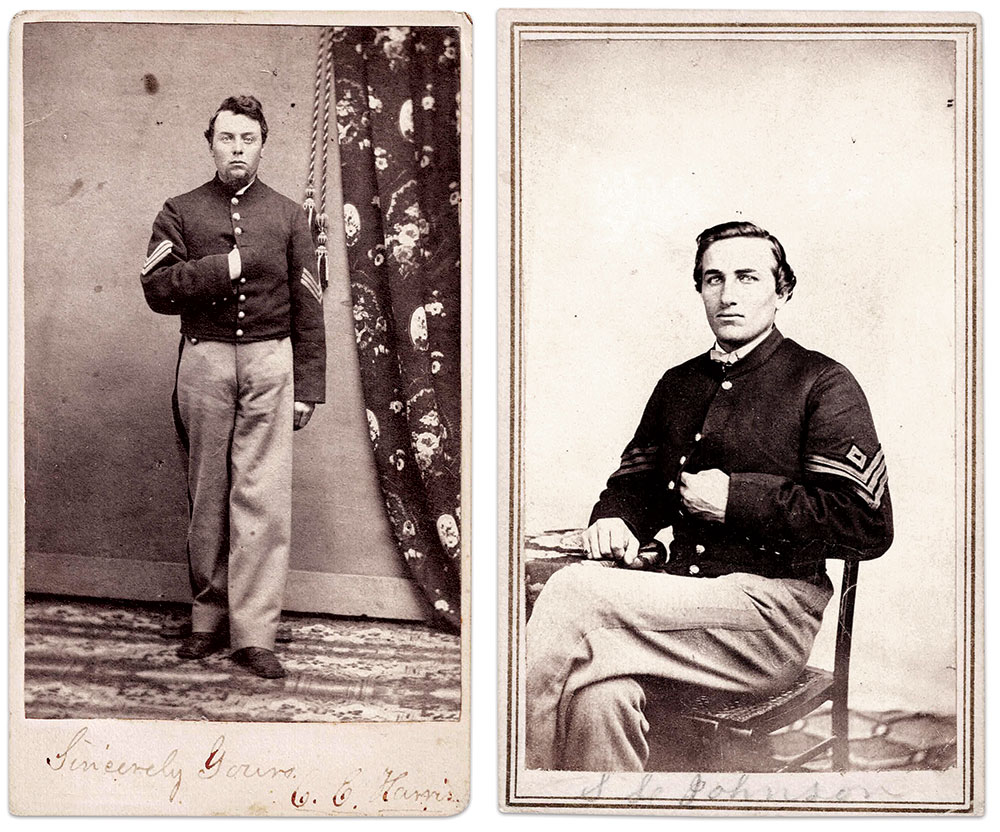By Richard M. Milstead, PhD
Enoch Whittemore, Jr., advanced to first sergeant on Feb. 4, 1864. A member of Company I of the 5th Maine Infantry, he had received several promotions since he enlisted in June 1861.
At some point after receiving his chevrons, Whittemore obtained this jacket. It was commercially made to civilian tailoring standards, not a standard government issue. Commonly referred to today as a “private purchase” garment, it is a nine-button, short jacket made from dark blue woolen broadcloth of higher quality than the fabrics used in government issued coats or blouses. Also notable is its fine, full alpaca-cotton lining.

The jacket’s six panel body pattern was derived from 19th century frock coats. Men’s garment design emphasized fit and an idealized body shape. This style was achieved through the pattern and the addition of chest padding and stiffened linen backing, called “chest canvas.” Linings usually displayed subdued richness in appearance. Alpaca, a blended fabric combining alpaca wool with silk or cotton, was commonly used.
Many soldiers that bought private purchase garments wanted a better fit rather than standard-issue uniforms. Some fancied more stylish garb. They procured them through army sutlers or military supply houses. Northern firms like Brooks Brothers of New York produced such clothing throughout the conflict. It is notable that officers and non-commissioned officers more frequently appear in period photographs wearing privately purchased coats than privates.
The maker of Whittemore’s jacket, however, is a mystery.
Another mystery is when Whittemore obtained it. Two other non-commissioned officers, both in Company K of the 5th, wore similar jackets in surviving carte de visite portraits: 1st Sgt. Simon L. Johnson and Sgt. Charles E. Harris. A handwritten note on Johnson’s carte indicates the image was taken on Feb. 9, 1864. A wartime image of Whittemore has yet to surface.

The February 1864 date falls during the time when the armies were in winter quarters.
The previous December, the state government offered officers and men the opportunity to reenlist, even though their original three-year terms were not set to expire until June 1864. About 100 men in the 5th took the offer, which included generous bounties and 35-day furloughs. Johnson and Harris took the time off and went home, as evidenced by New England photographers imprints on their cartes. They either purchased their new jackets before leaving for home or sometime on their journey north.
Whittemore did not reenlist. This suggests that he, along with Johnson and Harris, procured their jackets from a sutler or another source at winter camp rather than a Northern supplier. As similarly styled jackets were popular with officers and enlisted men throughout the army, and offered by many firms, it may never be possible to know where these three Maine men got them unless a receipt or other primary source is discovered.
Whittemore, Johnson and Harris joined the rest of the 5th and the Army of the Potomac on the Overland Campaign beginning in early May 1864. The regiment, part of Col. Emory Upton’s Brigade of the 1st Division in the Sixth Union Army Corps, fought in the Battle of Spotsylvania on May 10 and 12. The 5th lost more than half of its number in the battle. The casualty list included Whittemore, who suffered a leg wound that ended his service. Johnson and Harris were also wounded. Whittemore returned home before his term expired, and joined his surviving comrades in Portland on July 27, 1865, for the formal mustering out ceremony. He lived until 1918, dying at age 80.
Richard M. Milstead’s interest in American military material culture dates from the 1960’s and he has been reproducing period uniforms and equipment for over six decades. Dick has researched major uniform collections at institutions across the country, and has written research papers for the Company of Military Historian journal, Military Collector & Historian. A retired member of the North-South Skirmish Association (N-SSA), he is currently a research associate with the Liberty Rifles, a living history organization. A graduate of the University of Maryland (BS), MIT (SM), and New York University (PhD), Dick and his partner, Sandy, split their time between Rockport, Maine, and Annapolis, Md.
SPREAD THE WORD: We encourage you to share this story on social media and elsewhere to educate and raise awareness. If you wish to use any image on this page for another purpose, please request permission.
LEARN MORE about Military Images, America’s only magazine dedicated to showcasing, interpreting and preserving Civil War portrait photography.
VISIT OUR STORE to subscribe, renew a subscription, and more.

